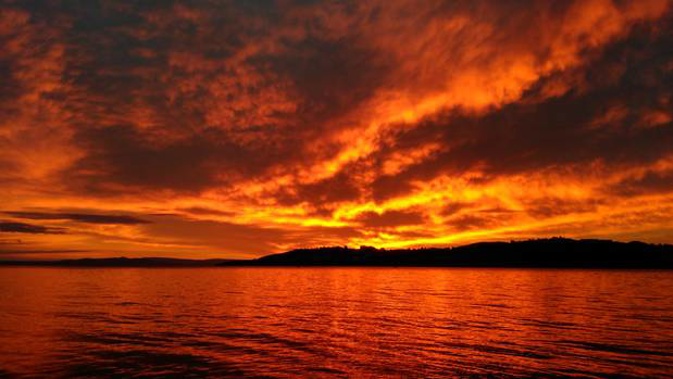
A new US study has used previous eruptions at Taupo to suggest catastrophic "supervolcano" blows would be signalled far in advance.
But New Zealand volcanologists have questioned the way the US researchers came to their findings, just published in the journal Geophysical Research Letters, and argue the huge caldera volcano's eruptive history has been too variable to pick trends from.
The researchers investigated changes in tectonic stress around so-called "supervolcanoes" - and from models based on Taupo, suggest these could act as warning signs.
They chose Taupo because of its tectonic setting, and their models indicated any tectonic stress would have a major effect on the stability of supervolcanoes.
"Any tectonic stress will help destabilise rock and trigger eruptions, just on slightly different timescales," said one of the study's authors, Haley Cabaniss at the University of Illinois at Urbana-Champaign.
"The remarkable thing we found is that the timing seems to depend not only on tectonic stress, but also on whether magma is being actively supplied to the volcano."
Using their model, the team looked at scenarios with different amounts of stress, tectonic plate movement and magma supply.
They found that in any given tectonic setting, the magma reservoirs inside of supervolcanoes appear to have remained stable for hundreds to thousands of years while new magma was being actively supplied to the system.
"We were initially surprised by this very short timeframe of hundreds to thousands of years," co-author Professor Patricia Gregg said.
"But it is important to realise that supervolcanoes can lay dormant for a very long time, sometimes a million years or more.
"In other words, they may remain stable, doing almost nothing for 999,000 years, then start a period of rejuvenation leading to a large-scale eruption."
The research suggested the precursors to catastrophic eruption would be far greater and long-lasting than anything yet documented.
"When new magma starts to rejuvenate a supervolcano system, we can expect to see massive uplift, faulting and earthquake activity," Gregg said.
"Far greater than the metre-scale events we have seen in recent time. We are talking on the range of tens to hundreds of metres of uplift.
"Even then, our models predict that the system would inflate for hundreds to thousands of years before we witness catastrophic eruption."
Cabaniss said the study suggested the entire rejuvenation-to-eruption process would take place over several or more human lifetimes.
"Our models indicate that there should be plenty of warning."
However, New Zealand scientists approached by the Herald weren't convinced by that headline finding.
One of New Zealand's most respected volcanologists, Victoria University's Professor Colin Wilson, pointed out among other concerns that the study only picked out two eruptive events.
The past 26,000 years have seen about 28 major eruptions, including one of the world's largest known: the devastating Hatepe eruption 1800 years ago.
Over that period, events have been separated in time by between 50 and 5000 years, with no simple pattern to suggest when or where the next event might occur.
Smaller eruptions had come after longer periods of rest, while larger ones had followed shorter lulls.
"If you are trying to model Taupo and ask if it's going to erupt in a big eruption, the point we've shown in studies we've done over the years is that eruptions are of randomised size," Wilson said.
"In other words, the system is operating on a totally different basis to what the nature of the surrounding stresses are."
Wilson, who is leading a Government-funded $8.2m, five-year study to clear up some of the uncertainty and hype surrounding "super-eruptions", said such external stresses were simply one factor.
"They've picked up on one thing and said this is the controlling factor, when in fact you can quite easily work out that, while external stress is important in certain ways, it can not control the fact there was 24,700 years between two caldera-forming events at Taupo."
University of Auckland volcanologist Professor Shane Cronin said while it was true there were long gestation periods of tens of thousands of years between big events, once the magma system was destabilised, the onset to eruption could be relatively quick – even a matter of months.
Cronin, the director of the Resilience to Nature's Challenges National Science Challenge, noted the other events at Taupo weren't considered by the study as the authors considered them too small.
"This may be true, but some of those 'tiddlers' covered hundreds of square kilometres of the North Island in thick ash fall and these would be a major disruption with potentially devastating impacts."
He also pointed the paper's assertion that tectonic extension, or stretching, would make the caldera's "roof" less stable, and that shifts in this process could trigger eruption relatively rapidly.
"This doesn't necessarily counter any other perspectives of magma assembly and eruption at large caldera systems," he said.
"Current theories are that there is always a certain amount of 'eruptible magma' at such large volcanic systems, but it often takes some kind of change in state to kick the system off – this may be either magma recharge or magma mixing.
"The jury is still a little out on whether extension itself may trigger eruptions or whether it indeed just creates more accommodation space for magma in the crust.
"If extension also generates conditions for recharge of hot new magma from the base of the crust or mantle into the crustal reservoirs – then that could lead to the trigger."
But Cronin said the interplay between volcanic and tectonic processes was often a
chicken-and-egg argument.
Take your Radio, Podcasts and Music with you









